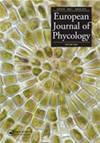The productivity effects of macroalgal biochar from Ulva Linnaeus bloom species on Arabidopsis thaliana Linnaeus seedlings
IF 1.7
4区 生物学
Q2 MARINE & FRESHWATER BIOLOGY
引用次数: 2
Abstract
ABSTRACT Intensive agricultural practices and poor management of organic waste have adverse effects on aquatic ecosystems, where excessive macroalgal proliferation can occur to form ‘green tides’, with negative environmental, ecological and socioeconomic impacts. One novel method for converting a problematic material into a valuable resource is to use excess algal biomass as a feedstock for biochar production. With a high elemental composition, such a resource might be suitable to redress soil deficiencies and to ameliorate soil fertility. Green macroalgae from the Ulva genus, in bladed (predominantly U. rigida), tubular (predominantly U. prolifera) and mixed morphological (U. rigida and U. prolifera) phenotypes, were used to produce biochars. A pot trial within a controlled-environment chamber was carried out to determine the effects of amending high- and low-fertilizer compost with algal biochars (applied at 0, 0.5, 1, 2 and 5% w/w) on the growth rate of Arabidopsis thaliana. A commercial wood-based biochar was used under similar treatments as a control. Weekly imaging and final harvest weights provided additional growth data; composition data including ultimate and proximate analyses, pH, Brunauer–Emmett–Teller (BET) surface area and hydropyrolysis of the dried macroalgae and algal biochars were also conducted. Significant enhanced growth in seedlings grown with biochar amendment were not observed in high- or low-fertilizer compost, and the addition of algal biochars at 5% w/w to high-fertilizer soil significantly reduced plant growth. Elemental analysis revealed that the algal biochars contained high quantities of alkaline elements including sodium. It was hypothesised that salinity was the primary factor affecting plant growth at higher biochar application rates, despite the algae being sourced from an estuarine environment. Biochar provenance and composition is highly significant: using the catch-all term ‘biochar’ ignores both the range of materials and composition that could be used to create it and its subsequent impact within the soil. HIGHLIGHTS First plant trial using biochar predominantly from Ulva species. Negative impact seen with 5% algal biochar on plant growth. High sodium concentrations putatively identified as reduced plant growth cause. Graphical Abstract林奈榆华种大藻生物炭对拟南芥幼苗生产力的影响
集约化农业实践和有机废物管理不善对水生生态系统产生不利影响,在水生生态系统中,大型藻的过度繁殖可能形成“绿潮”,对环境、生态和社会经济产生负面影响。一种将有问题的物质转化为有价值的资源的新方法是使用多余的藻类生物量作为生物炭生产的原料。由于其高元素组成,这种资源可能适合纠正土壤缺陷和改善土壤肥力。采用叶状(主要是刚性藻)、管状(主要是增生藻)和混合形态(刚性藻和增生藻)的Ulva属绿色巨藻生产生物炭。在受控环境室内进行盆栽试验,以确定在高、低肥堆肥中添加藻类生物炭(施量分别为0、0.5、1、2和5% w/w)对拟南芥生长速率的影响。在类似的处理下,使用商业木质生物炭作为对照。每周成像和最终收获重量提供了额外的生长数据;此外,还进行了大型藻类和藻类生物炭的最终和近似分析、pH、BET比表面积和加氢热解等组成数据的研究。在高肥和低肥堆肥中,添加生物炭对幼苗生长没有显著促进作用,在高肥土壤中添加5% w/w的藻类生物炭显著降低了植物生长。元素分析表明,藻类生物炭含有大量的碱性元素,包括钠。据推测,在较高的生物炭施用量下,盐度是影响植物生长的主要因素,尽管藻类来自河口环境。生物炭的来源和组成非常重要:使用包罗万象的术语“生物炭”忽略了可以用来制造它的材料和组成的范围以及它在土壤中的后续影响。首次植物试验主要使用来自Ulva物种的生物炭。5%藻类生物炭对植物生长的负面影响。高钠浓度被认为是植物生长减缓的原因。图形抽象
本文章由计算机程序翻译,如有差异,请以英文原文为准。
求助全文
约1分钟内获得全文
求助全文
来源期刊

European Journal of Phycology
生物-海洋与淡水生物学
CiteScore
4.80
自引率
4.20%
发文量
37
审稿时长
>12 weeks
期刊介绍:
The European Journal of Phycology is an important focus for the activities of algal researchers all over the world. The Editors-in-Chief are assisted by an international team of Associate Editors who are experts in the following fields: macroalgal ecology, microalgal ecology, physiology and biochemistry, cell biology, molecular biology, macroalgal and microalgal systematics, applied phycology and biotechnology. The European Journal of Phycology publishes papers on all aspects of algae, including cyanobacteria. Articles may be in the form of primary research papers and reviews of topical subjects.
The journal publishes high quality research and is well cited, with a consistently good Impact Factor.
 求助内容:
求助内容: 应助结果提醒方式:
应助结果提醒方式:


